Vintage Treasures: The New Hugo Winners, Volume III and IV, presented by Connie Willis and Gregory Benford
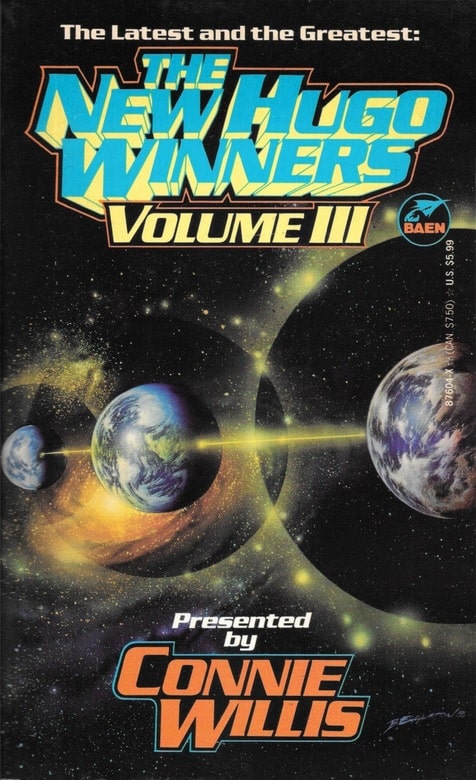 |
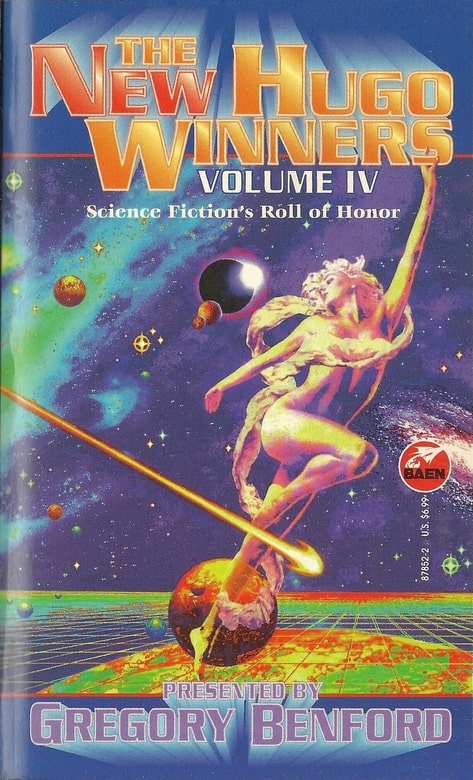 |
The New Hugo Winners, Volume III and Volume IV (Baen, and May 1994 and November 1997). Covers by Bob Eggleton
The Hugo Winners, Volume I and Volume II, edited by Isaac Asimov and collected in one big omnibus by the Science Fiction Book Club in 1972, was one of the top-selling science fiction books of the 70s, and Volume III (1977) was gladly received by readers. But by the time Volume IV and V were released in the mid-80s, sales had fallen off so significantly that neither one was ever reprinted in paperback, and Doubleday ceased publishing them entirely after the fifth book.
It was Martin H. Greenberg who talked Asimov into picking up the tradition with The New Hugo Winners in 1989. The two of them brought the series to Baen, and produced two volumes before Asimov’s death in 1992. Although Asimov had openly championed having Greenberg pick up the baton after his death, that didn’t happen. Instead it was Connie Willis and Gregory Benford who edited (excuse me, “Presented”) The New Hugo Winners, Volume III and Volume IV, as paperback originals from Baen Books in 1994 and 1997.
[Click the images for Hugo-winning large versions.]
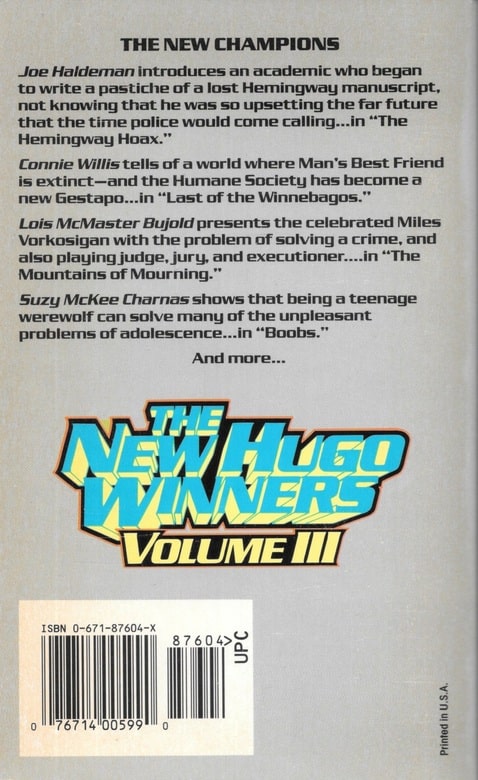 |
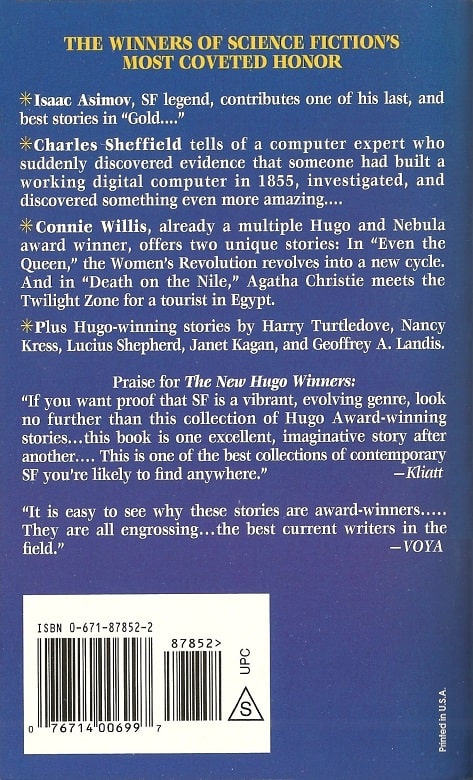 |
Back covers to The New Hugo Winners, Volume III and Volume IV
The New Hugo Winners, Volume IV was the last Hugo volume to appear, 26 years ago, and it brought a famed and much loved anthology series to an end. All told, there were ten Hugo anthologies: five volumes of The Hugo Winners (edited by Isaac Asimov and published in hardcover by Doubleday, 1962-1986), four volumes of The New Hugo Winners (published in paperback by Baen, 1991-1997), and The Super Hugos (Baen, 1992).
It’s hard not to compare the success of Asimov’s original volumes with the later ones. The Hugo Winners, Volume One, originally published in 1962, was reprinted over a dozen times and remained in print for nearly two decades. Volumes IV and V sold so poorly they essentially killed the series.
The series restart with Asimov and Greenberg, The New Hugo Winners, started off well, but never replicated the success of the earlier books. Only the first had a hardcover edition (The New Hugo Winners, Wynwood Press, 1989) and the last three were published as paperback originals. The final volume, The New Hugo Winners, Volume IV, presented by Gregory Benford, didn’t even have a Science Fiction Book Club reprint edition — the first time in their history the SFBC had declined to reprint a Hugo volume. It quickly went out of print, and (like all the Baen editions) has never been reprinted.
There’s no shortage of theories for why this happened. Plenty of people say that the series really died with Asimov, and it was his genial manner and entertaining introductions — and the casual way he took readers behind the scenes, telling personal anecdotes about each and every writer — that made the early books so interesting and readable.
And there’s certainly something to that. Like thousands of other science fiction fans who read Asimov’s Hugo Awards in their youth, it was his descriptions of the SF community as a tight-knit family of fascinating and brilliant individuals that first ignited my lasting interest in SF fandom — and indeed, in science fiction in general.
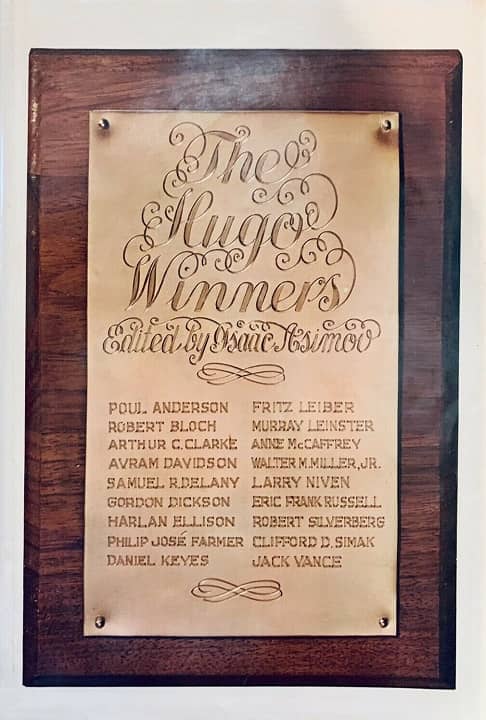 |
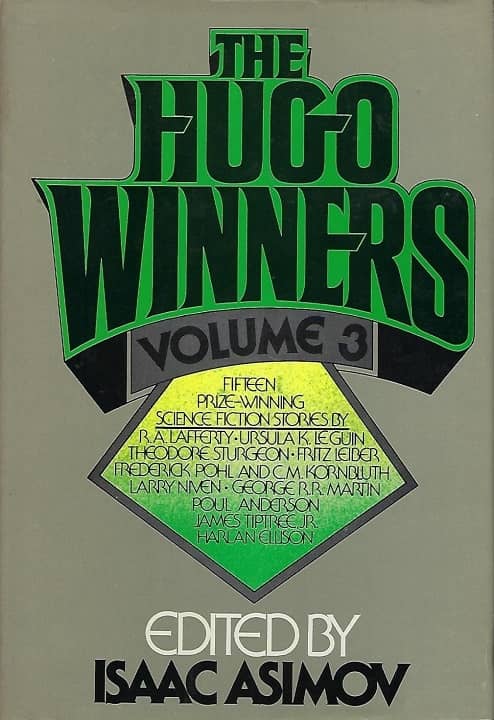 |
The Hugo Winners, Volumes I & II and The Hugo Winners, Volume 3 (Doubleday, 1972 and 1977).
Cover designs by F. & J. Silversmiths, Inc, and Robert Jay Silverman
However, Asimov’s later Hugo Volumes suffered from low sales, long before other editors took over. There are those, of course, who point to this as evidence that the field itself has been in a decline since the 70s, and modern SF simply isn’t as entertaining and readable as it used to be.
And there are plenty of folks who suggest that the Hugo voting process itself is irrevocably broken, and that the declining interest in the winners is evidence that the awards are no longer going to worthy recipients.
Personally, none of those theories hold much water for me. A glance at the Table of Contents of any Volume of The New Hugo Winners should suffice to prove that there’s no lack of quality among these winners. And as far as Asimov’s star power goes, at the end of the day, it’s the stories that we remember.
My own personal theory is that short fiction simply isn’t as popular or as marketable as it used to be. The declining sales of The Hugo Winners and its successor series The New Hugo Winners closely tracks with the overall decline in sales of science fiction anthologies of all kinds.
Where once bookstore shelves used to be filled with paperback anthologies and collections, they have all but vanished today — and don’t seem to be in any hurry to return. Science fiction magazines, once the core of the field, now survive with shrunken reader bases that would have meant certain death for any print SF mag of the 70s.
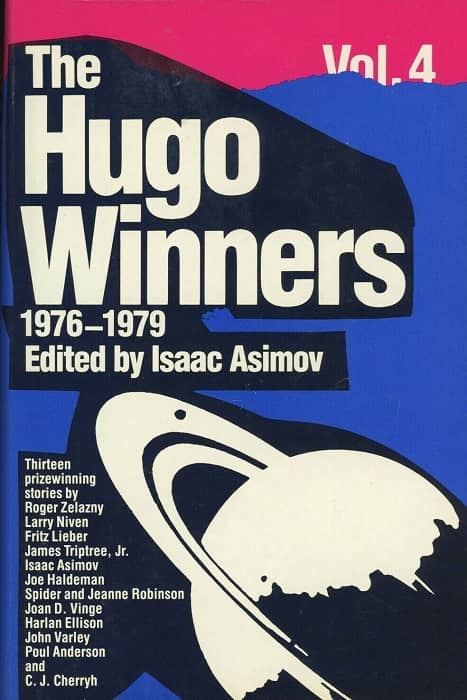 |
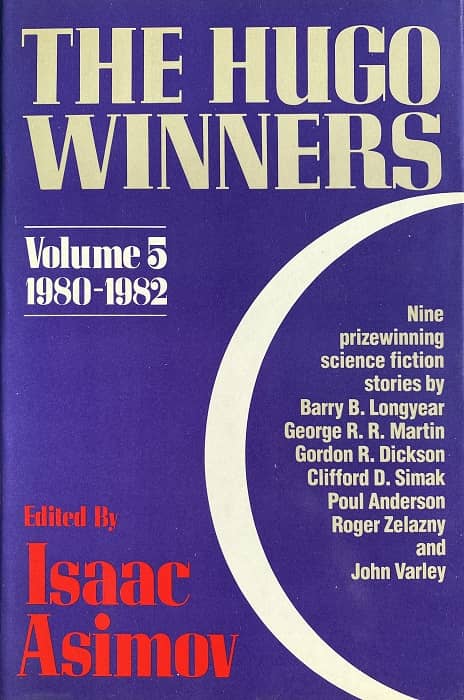 |
The Hugo Winners, Volume 4 and Volume 5 (Doubleday, April 1985 and April 1986). Covers by Kiyoshi Kanai and Tita Nasol
I very much miss paperback SF anthologies of all kinds. But the market has grown and expanded in so many other ways that I certainly have no shortage of things to read. And as readers of this blog are well aware, there’s no shortage of vintage anthologies to keep me busy, either.
The New Hugo Winners, Volume III was originally published in May, 1994, and collected the winners for 1989-1991. Did the Hugo voters get it right? You’ll have to decide that for yourself. Some of the stories they overlooked include:
“The Scalehunter’s Beautiful Daughter,” by Lucius Shepard
“Journals of the Plague Years,” Norman Spinrad
“Surfacing,” Walter Jon Williams
“Peaches for Mad Molly,” Steven Gould
“Do Ya, Do Ya, Wanna Dance?,” Howard Waldrop
“The Giving Plague,” David Brin
“Ripples in the Dirac Sea,” Geoffrey A. Landis
“Our Neural Chernobyl,” Bruce Sterling
“For I Have Touched the Sky,” Mike Resnick
“At the Rialto,” Connie Willis
“Dori Bangs,” Bruce Sterling
“Tower of Babylon,” Ted Chiang
Of those stories, my favorite is probably Steven Gould’s marvelous “Peaches for Mad Molly,” which I read in Gardner Dozois’ The Year’s Best Science Fiction: Sixth Annual Collection.
The New Hugo Winners, Volume III contains plenty of fiction that has endured the test of time, including a Budayeen novelette by George Alec Effinger, a Miles Vorkosigan novella by Lois McMaster Bujold, a Time Gate novelette by Robert Silverberg, and two tales in Mike Resnick’s Kirinyaga sequence. It also includes a heartfelt tribute to Asimov, disguised as Connie Willis’ Introduction.
Here’s the complete TOC for The New Hugo Winners, Volume III.
Introduction by Connie Willis
“Kirinyaga,” by Mike Resnick (The Magazine of Fantasy & Science Fiction, November 1988)
“Schrödinger’s Kitten,” by George Alec Effinger (Omni, September 1988)
“The Last of the Winnebagos,” by Connie Willis (Isaac Asimov’s Science Fiction Magazine, July 1988)
“Boobs,” by Suzy McKee Charnas (Isaac Asimov’s Science Fiction Magazine, July 1989)
“Enter a Soldier. Later: Enter Another,” by Robert Silverberg (Isaac Asimov’s Science Fiction Magazine, June 1989)
“The Mountains of Mourning,” by Lois McMaster Bujold (Analog Science Fiction and Fact, May 1989)
“Bears Discover Fire,” by Terry Bisson (Isaac Asimov’s Science Fiction Magazine, August 1990)
“The Manamouki,” by Mike Resnick (Isaac Asimov’s Science Fiction Magazine, July 1990)
‘The Hemingway Hoax,” by Joe Haldeman (Isaac Asimov’s Science Fiction Magazine, April 1990)
The New Hugo Winners, Volume IV was published in November 1997, and collected the winners for 1992-1994. Here are a few of the tales that didn’t make the cut.
“Griffin’s Egg,” Michael Swanwick
“And Wild for to Hold,” Nancy Kress
“Dispatches from the Revolution,” Pat Cadigan
“Fin de Cyclé,” Howard Waldrop
“Understand,” Ted Chiang
“In the Late Cretaceous,” Connie Willis
“Stopping at Slowyear,” Frederik Pohl
“Danny Goes to Mars,” Pamela Sargent
“The Mountain to Mohammed,” Nancy Kress
“The Arbitrary Placement of Walls,” Martha Soukup
“Wall, Stone, Craft,” Walter Jon Williams
“Into the Miranda Rift,” G. David Nordley
“The Night We Buried Road Dog,” Jack Cady
“Mefisto in Onyx,” Harlan Ellison
“England Underway,” Terry Bisson
And here’ the Table of Contents for The New Hugo Winners, Volume IV, edited by Gregory Benford, including the brilliant “Beggars in Spain,” part of Nancy Kress’ Sleepless series, and “Gold,” one of the last stories by Isaac Asimov.
“A Walk in the Sun” by Geoffrey A. Landis (Isaac Asimov’s Science Fiction Magazine, October 1991)
“Gold” by Isaac Asimov (Analog Science Fiction and Fact, September 1991)
“Beggars in Spain” by Nancy Kress (Isaac Asimov’s Science Fiction Magazine, April 1991)
“Even the Queen” by Connie Willis (Isaac Asimov’s Science Fiction Magazine, April 1992)
“The Nutcracker Coup” by Janet Kagan (Asimov’s Science Fiction, December 1992)
“Barnacle Bill the Spacer” by Lucius Shepard (Isaac Asimov’s Science Fiction Magazine, July 1992)
“Death on the Nile” by Connie Willis (Asimov’s Science Fiction, March 1993)
“Georgia on My Mind” by Charles Sheffield (Analog Science Fiction and Fact, January 1993)
“Down in the Bottomlands” by Harry Turtledove (Analog Science Fiction and Fact, January 1993)
Looking at the sources of the stores in these two books, it seems pretty clear that Asimov’s SF and Analog were where the action was for short science fiction in the late 80s and early 90s.
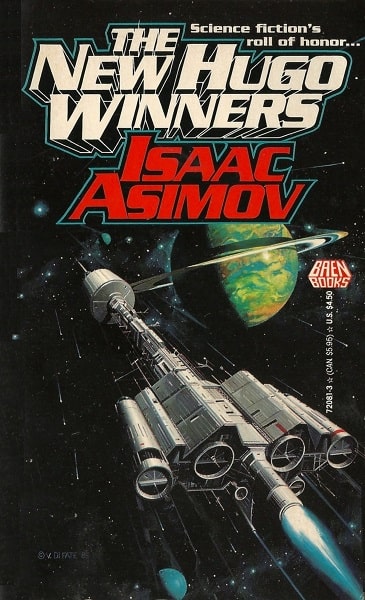 |
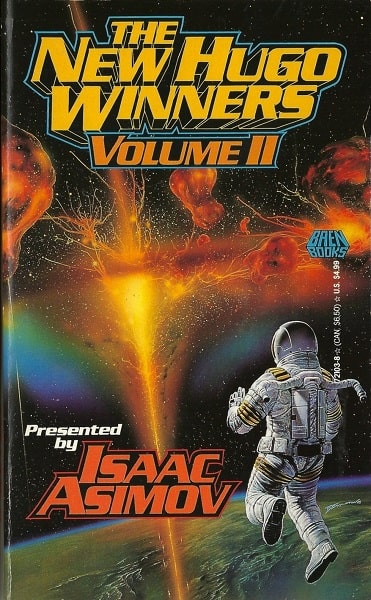 |
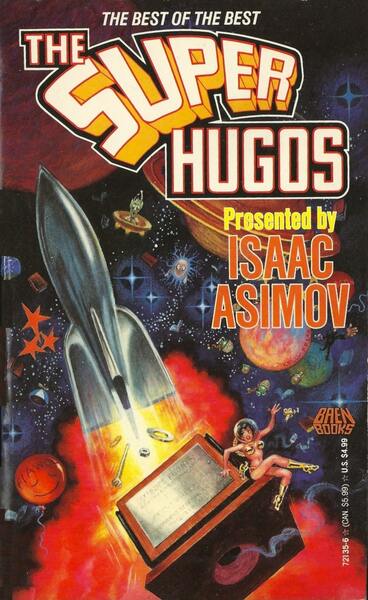 |
The New Hugo Winners, Volume I & II and The Super Hugos
(Baen, 1991, 1992, and 1992). Covers by Vincent Di Fate, Bob Eggleton, and Frank Kelly Freas
Here’s our previous coverage of Asimov’s Hugo Winners.
The Hugo Winners (Doubleday, 318 pages, $4.50 in hardcover, 1962) — cover uncredited
The Hugo Winners, Volume Two (Doubleday, 667 pages, $9.95 in hardcover, September 1971) — cover by Alan Peckolick
The Hugo Winners, Volumes One and Two (SFBC, 849 pages, $3.98 in hardcover, January 1972) — cover by F. & J. Silversmiths, Inc.
The Hugo Winners, Volume Three (Doubleday, 622 pages, $12.50 in hardcover, August 1977) — cover by Robert Jay Silverman
The Hugo Winners, Volume 4 (Doubleday, 575 pages, $19.95 in hardcover, April 1985) — cover by Kiyoshi Kanai
The Hugo Winners, Volume 5 (Doubleday, 384 pages, $18.95 in hardcover, April 1986) — cover by Tita Nasol
And here’s our coverage of all four volumes of The New Hugo Winners, plus The Super Hugos.
The New Hugo Winners, edited by Isaac Asimov and Martin H. Greenberg (Wynwood Press, 320 pages, $17.95 hardcover/$4.50 in paperback, December 1989) — cover by Vincent Di Fate
The New Hugo Winners, Volume II, edited by Isaac Asimov and Martin H. Greenberg (375 pages, $4.99 in paperback, January 1992) — cover by Bob Eggleton
The New Hugo Winners, Volume III, edited by Connie Willis (456 pages, $5.99 in paperback, May 1994) — cover by Bob Eggleton
The New Hugo Winners, Volume IV, edited by Gregory Benford (537 pages, $6.99 in paperback, November 1997) — cover by Bob Eggleton
The Super Hugos, presented by Isaac Asimov and edited by Martin H. Greenberg (424 pages, $4.99 in paperback, September 1992) — cover by Frank Kelly Freas
All five books were published in paperback by Baen, the last four as paperback originals. The first three were reprinted in hardcover by the SFBC, the last two have never had a hardcover edition. There are no digital editions.
See all of our recent Vintage Treasures here.
I can gladly concur with your dismissal of the “Declining quality of sf” theory for the lessening sales of anthologies like The New Hugo Winners. Those ToCs are chock-a-block with excellent works, and the non-winners that you list are also top-notch (“The Night We Buried Road Dog”, by Jack Cady, is a favorite of mine). Oh well, it is not like those disaffected fans were going to launch a hostile takeover of the Hugos, eh? Ehh??
Eugene,
“The Night We Buried Road Dog” is a stoppin’ story, and no mistake. I read it in Dozois’ Year’s Best Science Fiction: Eleventh Annual Collection (I think, thought it might have been in a Cady collection I bought from Mark Zeising).
I have to admit that I thought of the Puppy attempted takeover of the Hugos as I was writing those words about “folks who suggest that the Hugo voting process itself is irrevocably broken.” Though they are just a small (and extreme) subset of the complainers.
When you noted that “people say that the series really died with Asimov”, I think that’s part of why the Hugo Winner collections didn’t sell to the degree of their predecessors. Asimov’s introductions to the stories were pure gold, at least to a reader like me. Being before the internet, he provided a wealth of information about SF writers he knew personally and could convey it to readers. And he did it in such a manner that I’d read and reread the introductions to stories and authors whose works I didn’t particularly care for, but Asimov’s descriptions and anecdotes made them must reading. For example, I personally have never cared for Harlan Ellison’s short stories (sacrilege, I know), but Asimov’s introductions to Ellison’s stories I read over and over just because they were fun to read. And there were so many of them since Ellison won so many Hugo Awards.
I think you’re also correct on your assessment that short stories just aren’t really popular anymore. Going back to one of your posts from a few days ago about the “Isaac Asimov’s Wonderful Worlds of Science Fiction” series. That was one of many theme anthologies that appeared up through the early 1990s. Go into a Barnes & Noble and you’re hard pressed to find a short story theme anthology. Baen Books has done some that are edited by Hank Davis, but I haven’t seen much more than that.
On the plus side, there are still a ton of old short story anthologies I haven’t gotten to, and collecting those is one thing I’m working on, so there are a lot of stories to be read.
I think the real problem in keeping the series going was simple lack of organizational backing. If the World Science Fiction Society had been set up to do more than just organize Worldcons, it might have become a driving force to ensure the continuation of the anthologies. In contrast, the Science Fiction and Fantasy Writers of America has maintained regular publication of the Nebula Award anthologies through multiple editors and publishers fifty-three years and counting — even though Isaac Asimov only edited ONE of those!
Perhaps a bit of a tangent: I’m a huge fan of Kress’ early SF short fiction — from the late 70s and early 80s. I’ve been exploring her work slowly from her earliest period. A lot of readers jump to her much later stories like “Beggars” and ignore the earlier gems! “Talp Hunt” (1982) is a particular favorite of mine.